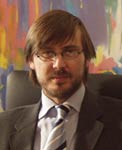 Professor Giovanni Scapagnini MD PhD
Professor Giovanni Scapagnini MD PhD
Assistant Professor, Institute of Neurological
Sciences, Italian National Research Council, Catania, Italy
Assistant Professor, Blanchette Rockefeller
Neurosciences Institute, West Virginia University, Rockville (MD),
USA
Visiting Professor, Institute of Human
Virology, University of Maryland, Baltimore (MD), USA
Professor Scapagnini attended the University of Catania School
of Medicine and Surgery in Catania, Italy and graduated in 1992 with
a medical degree. He continued his education by obtaining a Ph.D. in
Neurobiology also from the University of Catania in 2000. Since completing
his education, Dr. Scapagnini has conducted research with the Institute
of Pharmacology School of Medicine associated with the University of
Catania and has worked as a Visiting Scientist with Department of Surgical
Research, Northwick Park Institute for Medical Research, Harrow, UK
in 1999, and with Laboratory of Adaptive Systems, National Institute
of Neurological Disorders and Stroke, National Institute of Health
in Bethesda, MD, USA in 2000. Dr. Scapagnini currently holds two academic
positions as Assistant Professor with the Institute of Neurological
Sciences, Italian National Research Council and with Blanchette Rockefeller
Neurosciences Institute, West Virginia University. He has recently
obtained a visiting professorship with the Institute of Human Virology,
University of Maryland, where he is in charge of a research project
on HIV dementia. He is also the scientific director of the “Research & Progress” foundation,
founded by Dr Robert C. Gallo. He is author of 35 indexed scientific
papers and several book chapters. His fields of research regard gene
expression profiles of cellular stress response and biology and molecular
mechanisms of brain aging and nerurodegenerative disorders. In particular
he has studied the anti-aging activities of several nutraceuticals
present in the Mediterranean diet.
2008 - Brain ageing and cellular stress response
Giovanni Scapagnini, MD, PhD
Dept. Health Sciences, University of Molise, Italy
Oxidative stress has been implicated in a variety of pathophysiological conditions, including neurodegenerative disorders. Irrespective of the source and mechanisms that lead to the generation of reactive oxygen species (ROS), mammalian cells have developed highly regulated inducible defensive systems, whose cytoprotective functions are essential in terms of cell survival. When appropriately activated, each one of these systems has the possibility to restore cellular homeostasis and rebalance redox equilibrium. Activation of antioxidant pathways is particularly important for tissue with relatively weak endogenous antioxidant defenses, such as the brain. Increasing evidences, in fact, support the notion that reduction of cellular expression and activity of antioxidant proteins and consequent augment of oxidative stress are fundamental causes for aging processes and neurodegenerative diseases [1]. Among the molecules belonging to stress protein family, Heme oxygenase-1 (HO-1) has been the object of intensive studies in the brain for its potential role in protecting neurons against cell death. HO enzymes provide the first and rate-limiting step in heme degradation, to give biliverdin, gaseous carbon monoxide and free iron. All the byproducts of HO activity play a significant role in physiological cell functions [2]. In the CNS, the HO system has been reported to be very active [3, 4] and its modulation seems to play a crucial role in the pathogenesis of neurodegenerative disorders. Deregulation of the HO system has been associated with the pathogenesis of Alzheimer’s disease [5], multiple sclerosis and brain aging [6]. Many studies clearly demonstrate that activation of HO-1 in neurons is strongly protective against oxidative damage and cell death [7]. Thus, modulation of HO-1 should represent a potential pharmaceutical strategy for the treatment of neurodegenerative disorders. A number of experimental and epidemiological studies have recently supported the beneficial effects of some commonly used natural products in preventing various pathologic conditions ranging from cardiovascular diseases to cancer. Spices and herbs often contain phenolic substances with potent antioxidative and chemopreventive properties [8]. We have previously shown that curcumin (1,7-bis[4-Hydroxy-3-methoxyphenyl]-1,6-heptadiene-3,5-dione), a natural phenolic agent, extracted from the rhizome of Curcuma Longa, strongly induced HO-1 expression and activity in rat astrocytes [9]. We have then extended our findings demonstrating curcumin ability to induce HO-1 in cultured hippocampal neurons [10]. Our results indicate that curcumin activates HO-1 and phase II enzymes expression in astrocytes and neurons, probably by activation of transcription factor Nrf2, and this activation is able to effort a significant cytoprotection in cultured neurons exposed to oxidative stress. The involvement of curcumin in restoring cellular homeostasis and rebalancing redox equilibrium, suggests that it might be a useful adjunct also in the treatment of neurodegenerative illnesses characterized by inflammation, such as Alzheimer’s disease. This idea has been reinforced by epidemiological studies showing that, in India where this spice is widely used in daily diet, there is a reduced age-adjusted prevalence of AD (in patients between 70 and 79 years of age is 4.4-fold less than that of the United States) [11]. Consistent with its possible use in neurodegenerative diseases, curcumin has been reported to decrease oxidative damage and amyloid deposition in a transgenic mouse model of Alzheimer’s disease [12], and to reverse Aβ-induced cognitive deficits and neuropathology in rats [13]. Other plant-derived phenolic agents with analogous chemical structures to curcumin have been demonstrated to strongly activate HO-1 expression and to defend cells against oxidative stress. In particular we have shown that ethyl ferulate, resveratrol (a phitoalexin derived from grape) and caffeic acid phenethyl ester (CAPE), are able to protect neurons via HO-1 induction [14]. Our and other studies identifies a novel class of natural substances that could be used for therapeutic purposes as potent inducers of HO-1 in the protection of tissues against inflammatory and neurodegenerative conditions. It needs to be emphasized that curcumin, and other plant constituents eventually become part of the human diet and can be consumed daily as herbal supplements. Further in vitro and in vivo studies using curcumin-like molecules will give us important information on the feasibility of developing new pharmacological strategies for maximizing heme oxygenase activity in targeted tissues as an alternative to or in combination with HO-1 gene therapy.